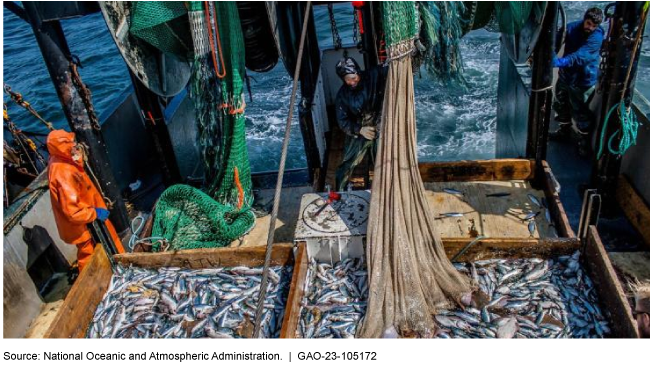Federal Fisheries Management: Overfishing Determinations Vary Across Regions, and Data Challenges Complicate Management Efforts
Fast Facts
The National Marine Fisheries Service (NMFS) manages fish stocks in federal waters. This includes working to prevent overfishing and giving fish stocks that are overfished a chance to rebuild.
NMFS offices submit information on overfishing and overfished stocks to a central database. But this database has some limitations—like not allowing staff to easily analyze trends over multiple years, which can be useful for tracking the extent of overfishing and overfished stocks over time.
NMFS is working to improve this database, but it doesn't have a written plan with goals and timelines for doing so. We recommended that NMFS develop such a plan.
NMFS Scientists Survey Fish Stocks off the Coast of New England

Highlights
What GAO Found
GAO's analysis of National Marine Fisheries Service (NMFS) data found that the number of fish stocks assessed for 2011 through 2020 varied by the six NMFS regional fisheries science centers and that many stocks were not assessed. For example, on average, the Southeast Science Center assessed about 10 percent of the 153 stocks it supported each year, while the Alaska Science Center assessed about 78 percent of its 64 stocks.
NMFS uses these assessments to support management, including determining whether a stock is in overfishing or is overfished. GAO found that the number of stocks in these statuses varied by science center and that many stocks had an unknown status (see fig. for overfishing information). Challenges inherent in collecting fisheries data, along with resource challenges, affected the availability and quality of the data. For example, trawl surveys, which are used to collect fisheries data, are challenging and costly to conduct over large geographic areas. These challenges were a key source of the variability in the number of stocks assessed and one of the reasons why many stocks may have unknown status.
Average Annual Number of Fish Stocks Experiencing Overfishing and Average Number with an Unknown Overfishing Status, by National Marine Fisheries Service (NMFS) Fisheries Science Centers for 2011 through 2020

Note: Some science centers are jointly responsible for assessing a fish stock. The averages do not total the amount noted in the report, due to rounding. A fish stock is a fish species or stock complex, which is a group of stocks similar enough to be managed as a single unit.
In reviewing NMFS' stock assessment and status data, GAO identified issues with the Species Information System database that prevented conducting certain multiyear trend analyses. NMFS has not documented these structural limitations or developed general guidelines for how to complete such analyses. NMFS officials noted that such analyses can be useful for tracking changes in stock status, as well as the frequency with which individual fish stocks have been assessed over time. NMFS is working on two projects to improve the functionality of the database. The plans for these projects do not include key project management elements, such as written goals and timelines. Developing a plan that includes these elements could help ensure completion of the projects and help NMFS conduct additional analyses that could be used to support management measures to prevent overfishing and manage overfished stocks.
Why GAO Did This Study
Commercial and recreational marine fisheries are a critical part of our nation's economy. These fisheries contributed $118 billion to the U.S. gross domestic product and supported 1.8 million jobs in 2019. NMFS and eight Regional Fishery Management Councils (Council) are responsible for managing about 460 fish stocks in federal waters. This includes minimizing the extent to which stocks experience overfishing or become overfished. Overfishing occurs when the number of fish caught is above a certain threshold; a stock becomes overfished when its population is deemed to be too low.
GAO was asked to review federal efforts to prevent overfishing and manage overfished stocks. Among other things, this report examines the number of stock assessments conducted from 2011 to 2020, along with the number and status of overfishing and overfished stocks during this period. GAO reviewed NMFS policies and documents; interviewed NMFS regions, Councils, and relevant stakeholders based on factors such as familiarity with different regions of the United States; and analyzed data from NMFS' Species Information System database.
Recommendations
GAO is making two recommendations to NMFS on the structural limitations of the Species Information System database, including developing guidelines for conducting certain multiyear analyses, as well as incorporating leading practices into its database improvement plans. The agency agreed with GAO's recommendations.
Recommendations for Executive Action
| Agency Affected | Recommendation | Status Sort descending |
|---|---|---|
| National Marine Fisheries Service | The Assistant Administrator for NMFS should develop a written plan for executing the Species Information System database improvement projects, including the project goals, the procedures to be followed, a timeline for completion, and a schedule for providing status updates. (Recommendation 2) |
Closed – Implemented
As of May 2023, NMFS has prepared written plans on its improvement projects for the Species Information System. Specifically, these plans established the goals of the projects, procedures to be followed, along with timelines for completion, and a schedule for providing status updates.
|
| National Marine Fisheries Service | The Assistant Administrator for NMFS should develop written documentation of the structural limitations of the Species Information System database, as well as general guidelines on how to conduct the manual editing needed for multiyear trend analysis and reporting purposes. (Recommendation 1) |
Open – Partially Addressed
As of May 2023, NMFS added a section to its Species Information System database user guide that provides information on the structural limitations of the database, but the agency has not established written general guidelines for how to conduct these analyses and the manual editing needed for multiyear trend analysis and reporting purposes.
|
